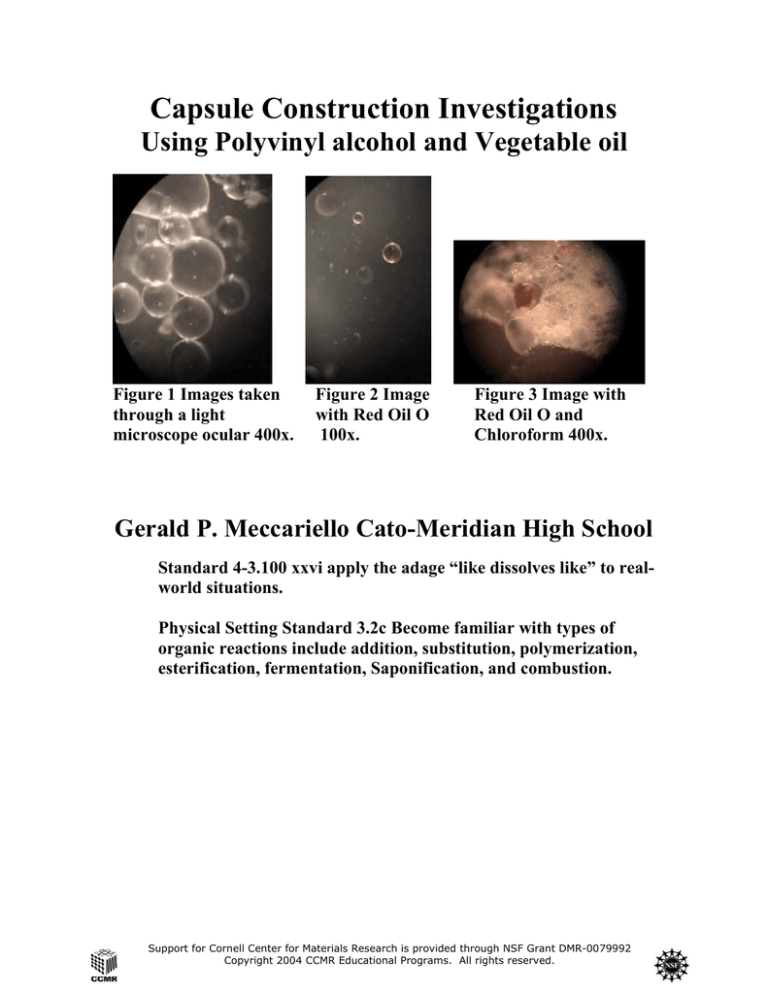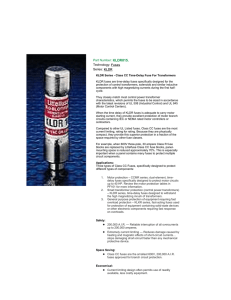
Capsule Construction Investigations
Using Polyvinyl alcohol and Vegetable oil
Figure 1 Images taken
through a light
microscope ocular 400x.
Figure 2 Image
with Red Oil O
100x.
Figure 3 Image with
Red Oil O and
Chloroform 400x.
Gerald P. Meccariello Cato-Meridian High School
Standard 4-3.100 xxvi apply the adage “like dissolves like” to realworld situations.
Physical Setting Standard 3.2c Become familiar with types of
organic reactions include addition, substitution, polymerization,
esterification, fermentation, Saponification, and combustion.
Support for Cornell Center for Materials Research is provided through NSF Grant DMR-0079992
Copyright 2004 CCMR Educational Programs. All rights reserved.
Introduction:
Capsules have been around for a long time. In 1957 BK Green
and L. Schleicher popularized the idea with a US patent for what we
commonly call NCR or no carbon required paper. That copying
process requires small capsules on the paper, which break and release
the chemicals for the copying process. The idea behind the formation of
capsules is to take two solutions with different polar properties, for
instance oil and water and then stir them so that little droplets are
formed. While the droplets are present a molecule, which has the
ability to exist in both solutions and polymerize with itself, coats the
droplets and forms a capsule. Capsules like this are used in many food
substances, cosmetic treatment, and medical applications including
drug delivery systems. I had the opportunity in the summer of 2004 to
work with Dr. T. McQuade and his research group who hope to use
capsules as vessels for organic reactions as a way of speeding up the
process of organic synthesis.
Materials:
Polyvinyl alcohol (PVA)
Vegetable Oil
Acetone
Borax
Oil soluble dye (optional)
Red Oil O, Sudan Black B
Water
Stir plate with magnetic stir bar
Microscope
Procedure:
1) Pour 50 ml of distilled water into a 250 ml beaker and stir as
high as practical, and heat to 45oC add .05 grams of PVA, allow
time for it to dissolve.
2) After the PVA is ALL dissolved add 2ml of an oil/acetone stock
solution made of 8 ml oil in 100 ml of acetone with oil soluble dye
if desired, last add 1 ml of saturated borax solution, continue to
stir for 15 minute.
3) Now the capsules can be removed and examined under a light
microscope at 100x or greater magnification.
Support for Cornell Center for Materials Research is provided through NSF Grant DMR-0079992
Copyright 2004 CCMR Educational Programs. All rights reserved.
Potential Educational Applications:
Plan
1) Class Demonstration
Time
20 min.
Description
Have capsules prepared
ahead of time so that upon
entry to class students can
look at the capsules under the
microscope even before class
begins. Show one sample
with the dye encapsulated
and one without, as an
introduction into solubility
rules, the dye could be either
oil or water soluble, it will
reside in a similar
environment (inside oil,
outside water).
2) Class Laboratory
40 min.
Have students make the
capsules and change the
following conditions;
concentrations of PVA, oil,
borax, also the pH, temp.,
and stirring speed all which
alter the capsule size.
3) Individual student
research
as interested
A single student could easily
change the conditions that the
capsules are made with and
record microscope images to
validate capsule changes. It is
even feasible to have the
student encapsulate different
molecules that are nonpolar.
Support for Cornell Center for Materials Research is provided through NSF Grant DMR-0079992
Copyright 2004 CCMR Educational Programs. All rights reserved.
SUMMARY
Skills and Concepts:
The skills depending on the use of this activity could include,
critical thinking, measuring volume and mass, microscope use, and
practice creating experimental designs. The main concepts in this
activity include solubility rules: 1) polar compounds dissolve in polar
solvents and nonpolar compounds dissolve in nonpolar solvents, 2)
monomers can link together to form polymers, which can form capsules.
Grade Subject/Theme/Level:
This activity is designed for 11th grade chemistry students and the
more capable the student the more freedom to explore the system
should be given.
Two different themes are central to this activity the first is
solubility rules and the second is the organic polymerization reaction.
Other high school themes include careful measurement critical
thinking when comparing different procedures and their outcomes.
This activity could be performed as a demonstration for lower level
students, as a lab for regents level students and it would make a fine
science fair project for advance level students.
ASSESSMENT
It would be my suggestion to assess the demonstration in a test format
using multiple choice questions or short answer. The lab activity should
require a written report. The science fair competition should be the
assessment for the student project version of this activity.
RESOURCES
1) http://chem.lapeer.org/chem 1 docs/SlimeDemo.html
“Polyvinyl alcohol slime” 2003
2) Rajaonarivony, M., Journal of Pharmaceutical Sciences vol. 82,
no. 9 Sept. (1993) 912-917, Development of a new drug carrier
made from alginate.
Support for Cornell Center for Materials Research is provided through NSF Grant DMR-0079992
Copyright 2004 CCMR Educational Programs. All rights reserved.
3) Fallouh, N.A.K., International Journal of Pharmaceutics, 28 (1986)
125-132, Development of a new process for the manufacture of
polyisobutylcyanoacrylate nanocapsules.
4) Bernstein, H., United States Patent 6,730,322, May 4, 2004, Matrices
formed of polymer and hydrophobic compounds for use in drug
delivery.
5) http://www.princeton.edu/~pccm/outreach/news/summerprogram.htm,
Summer Program for High School Students gives opportunity to
conduct research, work with faculty
6) http://www.rtdodge.com/fl-ovrvw.html, Flavor Encapsulation - An
Overview Ronald J. Versic, Ph.D. President, Ronald T. Dodge Company
Contributors
I would like to thank the following contributors who allowed this
project to be possible.
1) Cato-Meridian High School, 2854 Route 370 E. Cato, NY
2) Dr. T. McQuade, Cornell University, ST Olin, Ithaca, NY
3) Dr. John Terry, Cornell University, ST Olin, Ithaca, NY
3) Nevijinda Singhota, Cornell Center for Materials Research,
Cornell University, Ithaca, NY
4) National Science Foundation
5) The McQuade group especially Elizabeth Quevedo who spent a lot of
time at the SEM and TEM
Support for Cornell Center for Materials Research is provided through NSF Grant DMR-0079992
Copyright 2004 CCMR Educational Programs. All rights reserved.

